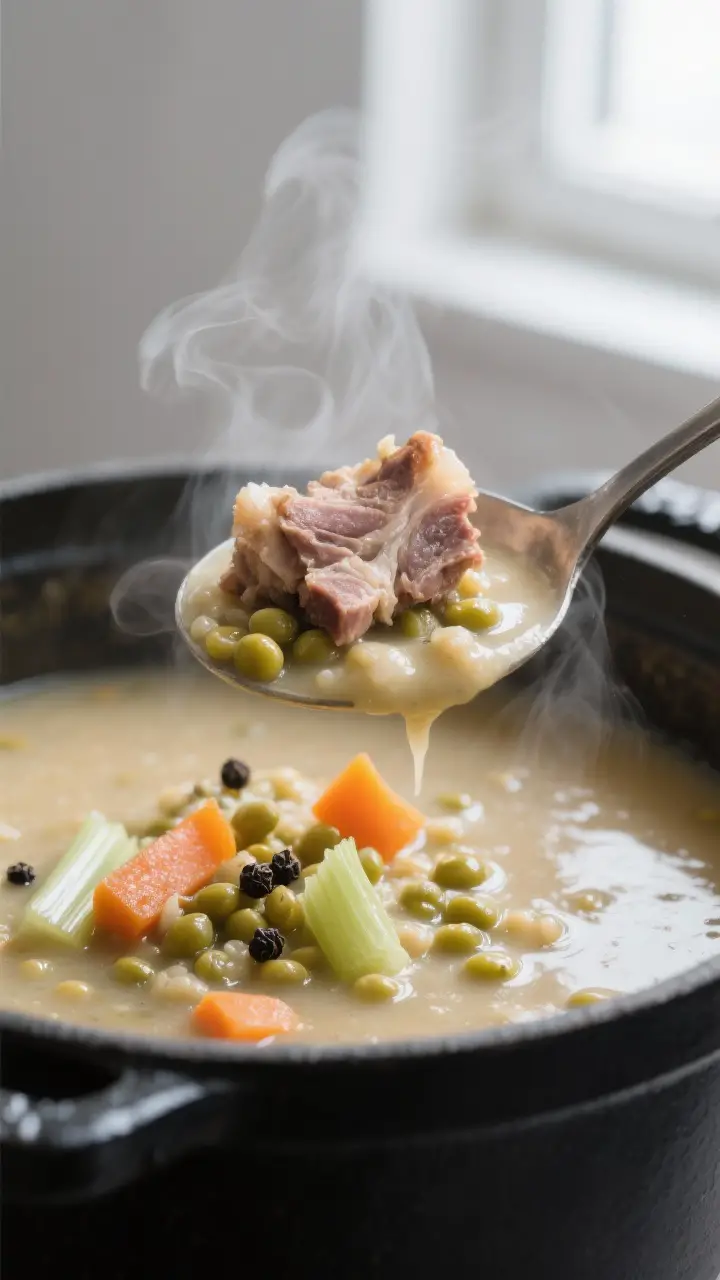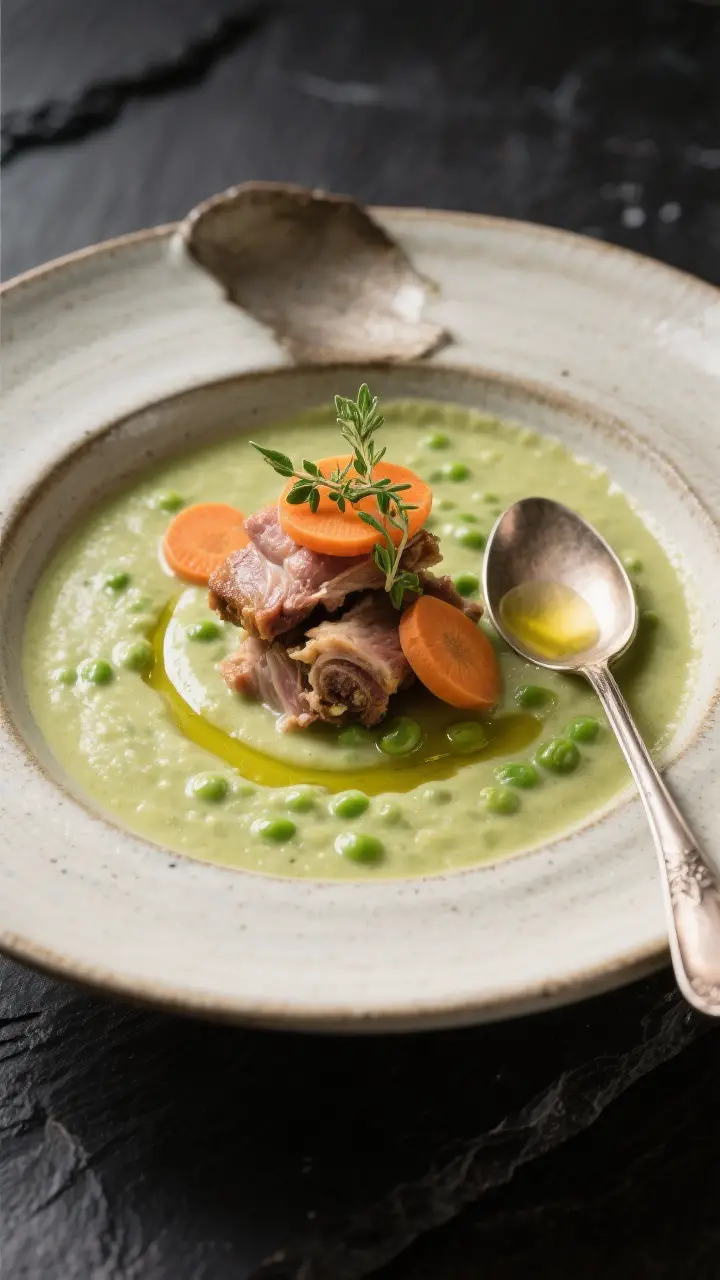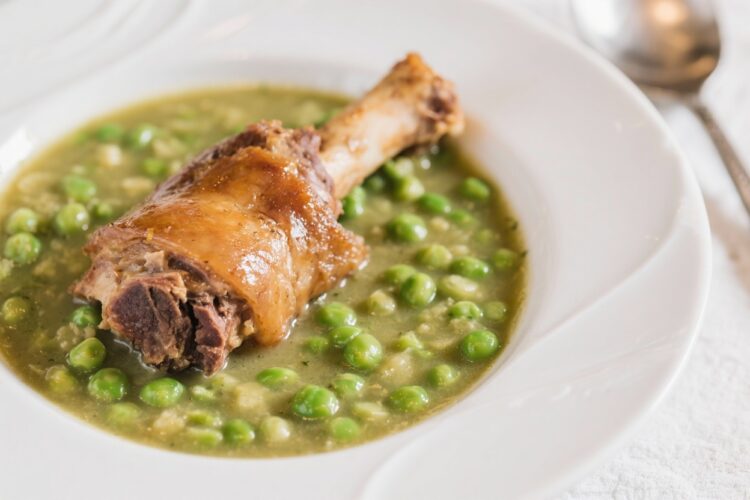Imagine a soup so rich your spoon stands straight for a selfie. This is old-world comfort with serious flavor ROI: tender, smoky eisbein melting into creamy split peas, all balanced with bright herbs and a sly splash of vinegar. It’s the kind of meal that turns a Tuesday into a feast and leftovers into bragging rights.
No culinary degree needed—just patience, a pot, and an appetite. Ready to feed your inner Viking and still feel virtuous afterward?
What Makes This Recipe So Good

- Smoky depth, naturally: Eisbein (cured, often smoked pork hock) infuses the broth with a savoriness you can’t fake with cubes or powders.
- Texture trifecta: Creamy peas, tender vegetables, and pull-apart pork give every bite substance. It eats like a meal, not a side quest.
- Budget-friendly, big yield: Split peas are cheap, and eisbein stretches—think multiple meals from one pot.
Your wallet will send a thank-you note.
- Hands-off cooking: Most of the time is simmering. Your job? Stir occasionally and look smug.
- Flavor control: A finishing hit of mustard and vinegar turns a good soup into a great one.
You’re the boss of brightness.
Shopping List – Ingredients
- 1–1.5 kg eisbein (pork hock), cured and preferably smoked
- 500 g dried split peas, rinsed and picked over
- 2 medium onions, diced
- 2 carrots, peeled and diced
- 2 celery stalks, diced
- 3–4 garlic cloves, minced
- 1 bay leaf
- 1 tsp black peppercorns (or 1/2 tsp ground)
- 1 tsp dried marjoram (or thyme)
- 1–1.5 L low-sodium stock (chicken or vegetable), plus water as needed
- 1–2 tbsp whole-grain or Dijon mustard
- 2–3 tsp apple cider or white wine vinegar
- Fresh parsley or dill, chopped (for garnish)
- Salt, to taste (careful—eisbein is salty)
- Optional add-ins: 1 medium potato (diced), 1 leek (sliced), a pinch of smoked paprika
How to Make It – Instructions

- Prep the peas. Rinse split peas in cold water until the water runs mostly clear. No soaking required, but a 30-minute soak helps them soften faster if you’re impatient.
- Rinse the eisbein. Give the pork hock a quick rinse to remove excess surface salt. Pat dry.
- Build the base. In a large pot, add peas, eisbein, onions, carrots, celery, garlic, bay leaf, peppercorns, marjoram, and stock.
Add enough water to cover by 2–3 cm.
- Bring to a simmer. Heat over medium-high until bubbling, then reduce to a gentle simmer. Skim any foam for a cleaner broth. Cover partially.
- Slow cook. Simmer 1.5–2 hours, stirring occasionally to keep peas from sticking.
Add water as needed to maintain your preferred thickness.
- Check tenderness. When peas are creamy and the eisbein yields easily to a fork, remove the hock to a board. Discard bay leaf.
- Shred the meat. Remove skin and excess fat (save the skin for the pot if you like more silkiness). Shred meat into bite-size pieces.
Return meat to the soup.
- Season smart. Stir in mustard and vinegar. Taste before salting—eisbein brings salt. Adjust with more vinegar for brightness or mustard for punch.
- Optional texture tweak. For extra creaminess, blitz a ladle or two of soup with an immersion blender, then stir back in.
Don’t puree everything—rustic > baby food.
- Finish and serve. Ladle into bowls. Top with chopped parsley or dill and a crack of black pepper. Serve with rye bread or crusty rolls.
Boom.
Storage Instructions
- Fridge: Cool completely, then store in airtight containers up to 4 days. It thickens as it chills; loosen with water or stock when reheating.
- Freezer: Portion into freezer-safe containers and freeze up to 3 months. Thaw overnight in the fridge and reheat gently on the stove.
- Reheating: Low and slow over medium heat, stirring to prevent sticking.
Add a splash of water to revive the silky texture.

Why This is Good for You
- Protein-packed: Eisbein delivers substantial protein, supporting muscle repair and satiety. Translation: fewer snack raids later.
- Fiber-forward: Split peas are fiber all-stars, which supports digestion and steady energy. Your gut will send a thank-you meme.
- Mineral-rich: Peas bring iron, magnesium, and potassium; bone-in pork contributes collagen and minerals for joint and skin support.
- Balanced comfort: It’s hearty without being a calorie bomb—especially if you skim some fat or go easy on the bread sides (I said “if”).
Don’t Make These Errors
- Oversalting early. Eisbein is salty.
Add salt only at the end after mustard and vinegar are in.
- Boiling hard. A rolling boil breaks peas unevenly and toughens meat. Keep it at a steady, friendly simmer.
- Skipping acidity. Without vinegar or mustard, the soup tastes flat. That tang is your flavor amplifier.
- Under-cooking peas. Grainy peas are a vibe-killer.
They should collapse into the broth for creamy body.
- Forgetting to stir. Peas settle and scorch. Stir every 15–20 minutes, especially as it thickens.
Alternatives
- No eisbein? Use smoked ham hock, smoked pork neck, or bacon plus pork shoulder. Aim for some smoke and some collagen.
- Vegetarian version: Skip the hock.
Use smoked paprika, a splash of soy sauce, and a Parmesan rind for umami. Finish with olive oil.
- Pea swap: Yellow split peas produce a slightly sweeter, golden soup—equally legit.
- Herb variations: Try thyme, bay, and a pinch of caraway. Dill at the end brings freshness.
- Texture tweaks: Add diced potatoes in the last 25 minutes, or stir in a handful of barley for chew.
FAQ
What exactly is eisbein?
Eisbein is a cured, often smoked pork hock popular in German and Central European cooking.
It’s collagen-rich, which makes soups glossy and meat ridiculously tender after slow cooking.
Can I make this in a slow cooker?
Yes. Add everything to the slow cooker, cover, and cook 8–9 hours on low or 4–5 on high. Shred the meat, return it to the pot, then finish with mustard and vinegar.
Stir and adjust thickness.
Do I need to soak split peas?
No soaking is required, but a short soak (30–60 minutes) can speed up cooking and reduce foaming. Rinsing is non-negotiable, though—get rid of dust and tiny debris.
How do I reduce the salt if my eisbein is very salty?
Parboil the hock for 10 minutes, discard the water, then proceed with the recipe. Also use low-sodium stock and add no salt until the very end.
Can I use a pressure cooker?
Absolutely.
Cook peas, aromatics, and eisbein on high pressure for 25–30 minutes, natural release 15 minutes. Remove the hock, shred, and finish with mustard and vinegar on sauté mode.
What should I serve with it?
Crusty bread, rye slices, or pretzels are classic. For a sharper contrast, serve with pickles or a simple mustard-dressed cabbage slaw.
Beer isn’t mandatory, but it’s not a crime either.
How thick should the soup be?
Personal preference. Traditional versions are thick enough to coat a spoon. If it gels too much after cooling, just whisk in warm water or stock while reheating.
Can I make it gluten-free?
Yes.
The base is naturally gluten-free; just ensure your mustard and stock are certified GF. Serve with GF bread or skip it—this soup stands on its own.
Final Thoughts
Eisbein Pea Soup is proof that simple ingredients, treated with time and respect, beat fancy tricks every day of the week. You get a pot of smoky comfort, a fridge full of easy meals, and the kind of flavor that makes takeout look silly.
Keep the acidity bright, the simmer gentle, and the spoon ready. When the bowl’s empty and everyone’s silently nodding, you’ll know you nailed it—no Michelin star required.
Printable Recipe Card
Want just the essential recipe details without scrolling through the article? Get our printable recipe card with just the ingredients and instructions.

